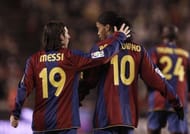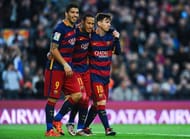With Barcelona already eight points clear at the top of the La Liga and qualifying very comfortably to the quarter-finals of the Champions League, our favorite sporting anomaly Lionel Messi is enjoying another corking season. He's already notched 30 goals in 39 games including finally sticking the ball past Gianluigi Buffon. Other than his club goals, he scored a significant hattrick in Argentina's make-or-break World Cup qualifier against Ecuador which was simply mind-blowing.
It has been more than 13 years since a very sprightly young Lionel stepped off the bench to make his Barcelona debut and essentially changed the football forever.
Filling the empty shoes of Ronaldinho

Barcelona was 1 goal up at Espanyol's old Olympic Stadium on 16th October 2004 and with 8 minutes to go, manager, Frank Rijkaard decided it was time for Deco to have a rest replacing him with the number 30 on the back of a shirt that was three sizes too big for 17-year-old Lionel Messi and onto the pitch he went, the youngest player to feature in an official match for Barcelona. He placed Messi on the right side of a front three that contained Ronaldinho and Henrik Larsson.
Messi started out at his hometown club Newell's Old Boys in Rosario, Argentina. After signing a contract literally written out on a paper napkin, he moved to Barcelona as a very small thirteen-year-old boy. Messi had been on growth deficiency treatment since he was 10 and after Barcelona agreed to pay for the treatment, Messi spent his boyhood at Barcelona training camp to be a great footballer.
Lionel Messi spent the following three years climbing through the ranks. He first trained with the senior team as a 16-year-old and after that very first session, Ronaldinho told his teammates that he reckoned Messi would become an even better player than himself. Ronaldinho took the tiny Messi under his arm, nicknamed him little brother and helped him in the training every day.
The little genius into the senior squads mostly played 77 minutes off the bench during the rest of his debut season and it wasn't really until the following year that he cemented his first-team place. His good performance was rewarded with a swanky new contract and a 150 million euro buyout clause.
Wearing the number 19 shirt, Messi basically slotted into the right side forming an attacking trio containing Ronaldinho and Samuel Eto'o but it wasn't until two years later when Ronaldinho left and handed Messi a more fitting number 10 shirt.
Wearing a number 10 shirt, Messi really held the game of football by his neck's scruff and lifted it to another planet. Messi's impact on the game of football for the 2008 season onwards is difficult to comprehend but the tactical nuance of Pep and his creation of the false 9 roles has truly induced a period of world domination from the Argentine.
Historical comparisons to his compatriot Maradona and contemporary ones to his nemesis Cristiano Ronaldo are basically unnecessary because Lionel Messi plays his own game individualistic, elegant, ruthless and just brilliant as fans were almost desensitized to his genius and his number defying stats were almost rendered useless by his consistency.
Messi is way above numbers but clubs are not and the amount of trophies Messi has brought to the Catalan club ensures that the legacy is not just his but Barcelona's. Over the last 13 years, Messi has been an indispensable part of eight La Liga trophies, five Copa del Rey's and four Champions League trophies.
Starting as the right-winger

During his time at youth and B teams, he liked to play as number 10 but in the senior team, that spot was occupied by Ronaldinho. As the result of this, Messi was deployed on the right flank in his early seasons (2004-08). After his debut in 2004, Messi became a regular starter in 2005 and played on his regular right wing position as a substitute.
In 2006, he became a regular starter and netted 17 goals in 36 appearances but the rise of Messi started when he returned from a 3-month injury in 2008 and scored 11 goals in 13 appearances which also included a hattrick in the El Clasico. Playing four years on the right flank, he improved his game a lot.
Playing as 'False 9'

Despite already being considered to be one of the best young players in the world, Messi's golden years were under the reign of Pep Guardiola. After the departure of Ronaldinho, Pep played Messi as 'False 9' and playing tiki-taka football, Barcelona had a great season winning the treble.
Playing as 'False 9', Messi was effective and it was glorified when Barcelona defeated Real Madrid by 6-2 at the Bernabeu in May 2009. Messi ended that season scoring 38 goals. Even after Pep's departure, Messi played 'False 9' until Luis Enrique's appointment in 2014.
Playing as CAM and RW

In 2014, Luis Suarez joined Barcelona from Liverpool and it was clear that he will play as number 10. Luis Enrique wasn't a big fan of 'False 9' and number 10 was already occupied by Suarez so he deployed Messi on the right flank.
Most of the fans thought that Messi will be playing in the same position as he played in his early years at Barcelona but Luis Enrique had something else in the mind. He instructed Messi to drop deep into the midfield area and play more like a CAM (Central Attacking Mid-fielder).
Playing as a CAM and RW (Right Winger), Messi scored 58 goals in 57 appearances in 2014-15. In the summer of 2017, Ernesto Valverde took the charge of Barcelona and he is going with the same style as Luis Enrique.
